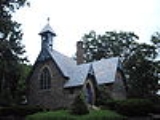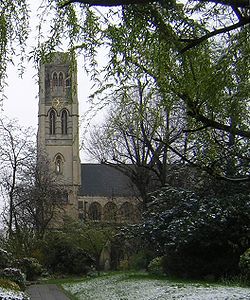
All Saints Notting Hill
Encyclopedia


Victorian era
The Victorian era of British history was the period of Queen Victoria's reign from 20 June 1837 until her death on 22 January 1901. It was a long period of peace, prosperity, refined sensibilities and national self-confidence...
Anglican church in Talbot Road, Notting Hill
Notting Hill
Notting Hill is an area in London, England, close to the north-western corner of Kensington Gardens, in the Royal Borough of Kensington and Chelsea...
, London
London
London is the capital city of :England and the :United Kingdom, the largest metropolitan area in the United Kingdom, and the largest urban zone in the European Union by most measures. Located on the River Thames, London has been a major settlement for two millennia, its history going back to its...
. It is a Grade II* listed building, built of stone with polychrome decoration in the Victorian gothic style. The west tower has five stages with the stump of a spire, and the sanctuary features paintings by Henry Holiday
Henry Holiday
Henry Holiday was an English historical genre and landscape painter, stained glass designer, illustrator and sculptor. He is considered to be a member of the Pre-Raphaelite school of art.-Early years and training:...
. The church was badly damaged by enemy action during World War II
World War II
World War II, or the Second World War , was a global conflict lasting from 1939 to 1945, involving most of the world's nations—including all of the great powers—eventually forming two opposing military alliances: the Allies and the Axis...
but was fully restored by 1951.
History
Construction on All Saints church was originally begun in the mid 19th century by the Reverend Dr Samuel Walker, following designs by architect William WhiteWilliam White (architect)
William White, F.S.A. was an English architect, famous for his part in 19th century Gothic Revival architecture and church restorations...
, working with Sir George Gilbert Scott. The church was to be the centerpiece of the development now known as Colville and Powis Squares. Walker was deeply religious and his vision was for a "free and open church" which would be a spiritual centre for the newly built neighbourhood. Unfortunately, he experienced severe financial difficulties and was eventually declared bankrupt. The building was left unfinished for several years, lacking a spire, and remaining unfurnished, during which time it became known as All-Sinners-in-the-Mud. It was eventually completed in 1861, by The Rev. John Light of Trinity College Dublin, at a cost of £25,000. The spire envisioned in White's original designs was never completed.
The tower is 100 feet high and is said to resemble the medieval Belfry of Bruges
Belfry of Bruges
The belfry of Bruges, or Belfort, is a medieval bell tower in the historical centre of Bruges, Belgium. One of the city's most prominent symbols, the belfry formerly housed a treasury and the municipal archives, and served as an observation post for spotting fires and other danger...
, Belgium
Belgium
Belgium , officially the Kingdom of Belgium, is a federal state in Western Europe. It is a founding member of the European Union and hosts the EU's headquarters, and those of several other major international organisations such as NATO.Belgium is also a member of, or affiliated to, many...
.
Walter Passmore
Walter Passmore
Walter Henry Passmore was an English singer and actor best known as the first successor to George Grossmith in the comic baritone roles in Gilbert and Sullivan operas with the D'Oyly Carte Opera Company....
(1867–1946), the singer and actor best known for his comic baritone roles in Gilbert and Sullivan
Gilbert and Sullivan
Gilbert and Sullivan refers to the Victorian-era theatrical partnership of the librettist W. S. Gilbert and the composer Arthur Sullivan . The two men collaborated on fourteen comic operas between 1871 and 1896, of which H.M.S...
operas with the D'Oyly Carte Opera Company
D'Oyly Carte Opera Company
The D'Oyly Carte Opera Company was a professional light opera company that staged Gilbert and Sullivan's Savoy operas. The company performed nearly year-round in the UK and sometimes toured in Europe, North America and elsewhere, from the 1870s until it closed in 1982. It was revived in 1988 and...
, was a choirboy at All Saints.
World War II and The Blitz
The church suffered from severe bomb damage in World War IIWorld War II
World War II, or the Second World War , was a global conflict lasting from 1939 to 1945, involving most of the world's nations—including all of the great powers—eventually forming two opposing military alliances: the Allies and the Axis...
during The Blitz
The Blitz
The Blitz was the sustained strategic bombing of Britain by Nazi Germany between 7 September 1940 and 10 May 1941, during the Second World War. The city of London was bombed by the Luftwaffe for 76 consecutive nights and many towns and cities across the country followed...
, along with neighbouring buildings such as Pinehurst Court
Pinehurst Court
Pinehurst Court is a portered Victorian mansion block at 1-9 Colville Gardens, just off Colville Terrace and near the Portobello Market in Notting Hill, London, England.-History:...
, at 1-9 Colville Gardens. The first bombs fell on September 26, 1940, and the church was hit again in March and June 1944. The Lady chapel and the south transept chapel were destroyed. Restoration work was eventually completed in 1951.
From 1931-1961, the vicar was the flamboyant Fr John Twisaday, who established a tradition of "high church" worship at All Saints, which to some extent continues to this day.
Former Vicars
- 1861-1885 Fr John Light
- 1885-1896 Fr Robert Trench
- 1896-1907 Fr Philip Herbert Learyk
- 1907-1931 Fr Herbert Ridley
- 1932-1961 Fr John Herbert Cloete Twisaday
- 1961-1966 Fr John Herbert Brewer
- 1966-1967 Fr John Henry Dixon
- 1967-1974 Fr Peter Clerk
External links
- Official All Saints website Retrieved February 20, 2010
- The Illustrated London News, Sept. 8, 1866, p.245 Retrieved February 20, 2010
- History of the Portobello and St Quintin Estates, FHW Shepherd (General Editor) Retrieved February 20, 2010
- All Saints church at Images of England Retrieved February 20, 2010
- Holland Park Ave at Project Gutenberg Retrieved February 20, 2010

